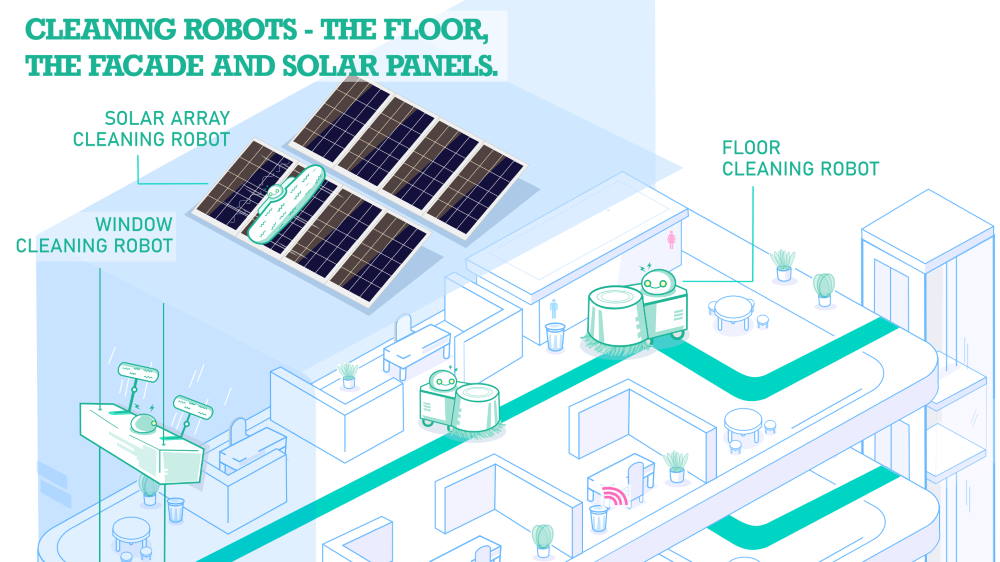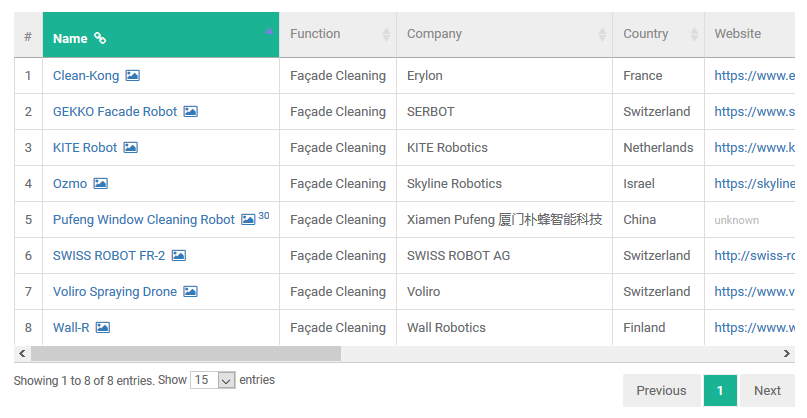
Image credit: TechObjects.io
1.5 FLOOR CLEANING ROBOTS
Floor cleaning or scrubbing robots are generally autonomous mobile robots that specializes in cleaning, scrubbing and vacuuming floor surfaces. These robot janitors can autonomously perform cleaning work along a pre-planned cleaning map and self-navigate to charging stations for automatic re-charge, freeing up cleaning staff for more intricate cleaning tasks that robots cannot handle, such as cleaning of door handles, elevator buttons, furniture and light switches.
With the Covid-19 outbreak, increased cleaning requirements and limited labor supply during the outbreak has accelerated the disruption of the cleaning services industry - an industry that has traditionally relied on human labor. Cleaning robots provide consistency and reliability in cleaning, and are not fallible to diseases.
With the intent to perform floor disinfection, some floor scrubbing robot models have been further fitted with UV-C irradiation modules at the underbelly of the robots to support floor disinfection. However, operators will need to be mindful of the delicate balance between cleaning speed and disinfection effectiveness, as the effective UV-C exposure time needed to deactivate viruses is around 5 to 20 seconds at a 10-cm distance between UV-C source and the target surface. This would imply a considerably lower cleaning productivity at a speed of around 10-20cm per 5 second or 2-4cm/s, which is slower than the typical speeds of floor scrubbing robots at 1m/s.
SUMMARY OF CONSIDERATIONS
MARKET LEADER BY SALES: SOFTBANK ROBOTICS WHIZ
Softbank Robotics's Whiz has the highest sales among autonomous professional cleaning robots, having sold more than 10,000 units at the end of June 2020. According to Softbank Robotics, Whiz has captured 55% market share of the autonomous professional cleaning robot market and has cleaned floorspaces equivalent to over 335,000 km, or approximately 8.5 laps around the world.
Whiz has an operating time of four hours on a single charge. It is highly suited for carpeted and hard surfaces, and can clean an area of up to 1,500m2 in three hours. In response to the Covid-19 outbreak, Whiz will soon be equipped with a disinfection agent to disinfect walls, door knobs and other surfaces inside buildings.
MARKET CASE: CINCINNATI/NORTHERN KENTUCKY INTERNATIONAL AIRPORT
Cincinnati/Northern Kentucky International Airport (CVG) is a Skytrax award-winning airport that has been named the Best Regional Airport in North America in 2020. CVG is also the first U.S. airport to deploy Avidbot's Neo floor scrubbing robot. CVG's pilot trial with Neo began in November 2019 and during the trial, Neo cleaned an average of 200,000 square feet of the airport's floors per week.
Neo costs around $50,000 and has an operating time of six hours on a single charge, with an expected five-year usage period. Aside from CVG, Neo has already been widely used in airports worldwide including Paris Charles de Gaulle, Singapore Changi, Tokyo Narita, Tokyo Haneda, Osaka Kansai, Montréal-Pierre Elliott Trudeau International and Ben Gurion.
MARKET CASE: PITTSBURGH INTERNATIONAL AIRPORT
To enhance the cleaning program within its high-traffic premises, Pittsburgh International Airport (PIT) teamed up with Pittsburgh-based Carnegie Robotics to incorporate disinfection technologies into its autonomous floor scrubbing robots built by Danish firm Nilfisk.
With the disinfection modifications by Carnegie Robotics, the robot cleaners first scrub the floor surface with 88 pounds per square inch of water pressure and apply chemical disinfectant to the surface for a deeper clean. As a third step, the scrubber passes over and disinfects the cleaned surface with UV-C irradiation fixture at the back.
MORE FLOOR CLEANING ROBOTS
Discover other floor cleaning robots that we have not covered within this report in this list.
1.6 FAÇADE CLEANING ROBOTS

Image credit: TechObjects.io
Cleaning the façade of a high-rise building is one of riskiest building maintenance jobs, with potential dangers ranging from injuries to fatal falls due to malfunctioning equipment, poor weather, lapses in judgement or failure to put on PPE (personal protection equipment). Improperly secured equipment and working tools can also lead to property damage and cause great harm to pedestrians and bystanders on the ground.
Façade cleaning robots reduce a good deal of these risks by eliminating human lapses. In addition, robots provide consistent cleaning to the façade and pose no disturbance to staff and tenants working in offices.
MARKET CASE: GEKKO @ FESTO AUTOMATION CENTRE, GERMANY
Festo Automation Centre, a building tower located in Esslingen, Germany, has used the GEKKO facade-cleaning robot developed by Serbot AG to maintain its glass facade. Using its patented drive system and proprietary suction technology, GEKKO is able to navigate and change directions across vertical glass surfaces gracefully and securely.
As an outcome, the GEKKO robot is able to achieve an impressive cleaning performance of around 400m2 an hour, leading to considerable time and cost savings. Thus, the entire 8,500m2 facade surface area can be smoothly cleaned in a few days. The GEKKO robot is securely supported and receives electrical power and demineralized cleaning water supply via cables from an electronically controlled roof trolley at the top of the building.
MARKET CASE: KITE ROBOTICS @ UTRECHT CENTRAL STATION, NETHERLANDS
Utrecht Central Station is the largest and busiest railway station in the Netherlands, handling more than 190,000 passengers and 1,000 train departures daily. Its new platforms sport a glass canopy roof that is now washed and cleaned by the KITE window cleaning robot every month.
As a busy transit hub, Utrecht Central Station needed a cleaning solution that does not require scaffoldings or manual hydraulic systems which can obstruct traffic flow. Thus, an autonomous robotic cleaner that is cable-secured atop the glass roof fitted well with the desired solution. The cable system enables the KITE robot to precisely navigate the contours of the roof surface in any direction. The KITE robot performs its cleaning with a large rotating brush and a supply of demineralized cleaning water, adhering to a cleaning path that can be pre-programmed in advance.
MARKET CASE: EY MIDTOWN BUILDING, ISRAEL
Completed in 2017, the CanadaIsrael Midtown building is one of the tallest buildings in Tel Aviv, Israel, standing at 196 meters with 50 floors above ground. It also houses some of the most prominent firms in the world, including WeWork and Ernst & Young which occupies 21 floors of the building.
Ozmo, SkyLine Robotics's window cleaning robot, cleans the facade of the building with remote guidance from a trained operator. Ozmo works with different types of facade surfaces and uses its in-built computer vision to navigate along the facade and can be trained to detect and avoid obstacles safely without damage to property or harm to humans.
MORE FACADE CLEANING ROBOTS
Discover other facade cleaning robots that we have not covered within this report in this list.
1.7 SOLAR PANEL CLEANING ROBOTS

Image credit: TechObjects.io
It is increasingly commonplace to find solar arrays, also known as photovoltaic PV systems, mounted on sun-facing roofs or walls of buildings. For building managers, solar power does pack an attractive return on investment, with the potential to reduce the electrical bill by 5-10% for buildings with very high air conditioning usage. This easily translates to savings of tens of thousands of dollars annually.
However, solar panels will need to be cleaned and maintained as environmental dust and grime accumulation can reduce their exposure to sunlight by 5-10% and affect electrical production, thereby reducing financial savings. Solar cell manufacturers recommend that the cleaning of solar panels at least once a year to ensure optimal production.
MARKET PLAYER: SERBOT PVCLEAN
From the firm that developed GEKKO the facade cleaning robot, Serbot AG has also developed pvClean for low-slope solar panels i.e. panels with an installation angle of 15 to 20 degrees.
pvClean can clean at an efficiency of 600m2 per hour at a driving speed of 18 to 24 meters per minute. It cleans with a pair of rotating brushes and a supply of demineralized water.
MARKET PLAYER: INDIBOTS R12
Developed by Indibots of India, the Indibots R12 is offered as a service to clean solar panels across vast solar farms or difficult-to-maintain solar rooftops.
Indibots R12 is self-powered and performs dry cleaning, instead of water-based cleaning, to remove dust on the solar panels. A single Indibots Robot can complete the cleaning of a 7MW solar plant with more than 20,000 panels within 3 days.
MARKET PLAYER: SOLARCLEANO
Solarcleano is a remote-controlled solar panel cleaning robot that can handle solar panels that tilted at angles of up to 25 degrees. It is highly modular with detachable brush components and weighs about 25kg, enabling the robot to be easily carried across rows.
Solarcleano can be fitted with two brushes, in the front and in the rear, and with soft bristles for cleaning dust and hard bristles for wiping adhesive dirt. It is capable of working continuously for 3 to 3.5 hours on battery.
CONCLUSION OF REPORT 1

Image credit: TechObjects.io
In Report 1, we have explored the various aspects of "smarter" cleaning for a building - from surface and space disinfection to restroom cleaning to waste clearing and cleaning of floors, rooftop panels, facades - that can now be greatly enhanced through the use of IoT and robotic solutions. Smarter and deeper cleaning for buildings has certainly become more pertinent, especially so with new and more stringent hygiene requirements introduced since the Covid-19 outbreak.
In the next report of our smart building series, we explore how the ongoing pandemic has affected the flow of things and people within buildings - from new screening needs for building users and visitors, to smarter goods and people flow within buildings through connected elevators and delivery robots that interface with elevators for vertical autonomous navigation, and low or no touch experiences through the building.
CONTRIBUTORS





